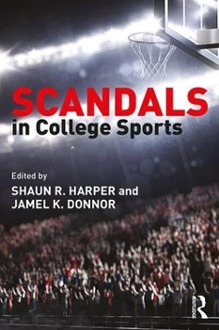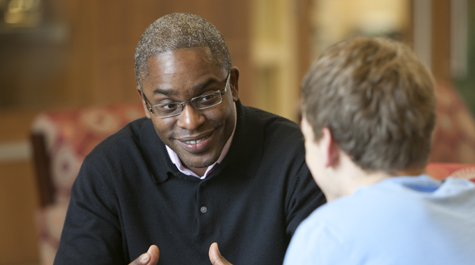New book explores infamous scandals in college sports
It’s that time of year where all eyes are trained on brackets, hoops and young phenoms with dreams of making it big in the NBA. But, amidst the spectacle of March Madness, there’s a different kind of madness that’s becoming increasingly more visible in college sports — scandals.
In Scandals in College Sports, co-editors Jamel K. Donnor, the William and Martha Clairborne Stephens Distinguished Associate Professor of Education at William & Mary, and Shaun R. Harper, the Clifford and Betty Allen Professor in the Rossier School of Education at the University of Southern California, discuss the causes and consequences of crime and misconduct in collegiate athletics and offer alternative scenarios for how the situations could have better played out.
 “There’s a lot of hypocrisy in college sports primarily because you have these student-athletes who are supposed to be playing purely for love of the game, but then there’s this multi-billion-dollar industry that’s driving a lot of the decision making,” Donnor said. “There’s pressure to win no matter the costs, which in turn makes people do things they know they shouldn’t do.”
“There’s a lot of hypocrisy in college sports primarily because you have these student-athletes who are supposed to be playing purely for love of the game, but then there’s this multi-billion-dollar industry that’s driving a lot of the decision making,” Donnor said. “There’s pressure to win no matter the costs, which in turn makes people do things they know they shouldn’t do.”
Donnor and Harper, who met in graduate school, decided to team up on the project after noticing the steady stream of controversy that surrounds college sports, dating as far back as the very first intercollegiate athletics contest in the U.S. — a boat race between Harvard and Yale in 1852 in which teams were both illegally compensated for the match and caught cheating.
A century later, money is still a major cause for athletic wrongdoings, leading recruiters to bribe potential players (such as the University of Alabama’s 1999 paid recruitment of Albert Means); players to cheat on exams and papers (like Florida State University’s academic fraud case in 2007); and coaches to intentionally conceal the truth (Penn State’s Jerry Sandusky sex-abuse scandal).
“I think, in all fairness, it’s the pressure to win that’s at the root of all of these scandals,” said Donnor. “When you’re consistently winning, schools can use that as a recruiting tool and a branding mechanism. It brings in more money from donors and ticket sales and can even result in additional funds from the state legislature. Winning definitely helps.”
The book, released in February, chronicles 21 of the most infamous pitfalls in college sports, from cases of extortion and drug use to sexual abuse. Each chapter explores the cases in great detail, including what exactly happened, how the infraction came to light, what the penalties were and whom it affected most severely.
“One of the things we wanted to highlight here is that it’s usually the students that get hurt by these scandals the most,” said Donnor. “The higher ups are usually compensated very well and rebound nicely, but the students often get blackballed. If a student athlete slips up, a lot of the times it’s one strike and they’re out.”
In each chapter, the writers (many of them scholars and former athletes) also hypothesize as to why the scandal was handled the way it was and what the key players could have done differently. In a situation involving the Ohio State University men’s football team and former head coach Jim Tressel, for example, players traded sports memorabilia in exchange for money and free tattoos from the owner of a local tattoo parlor. When Tressel found out, he failed to notify the school, resulting in an NCAA violation.
“He took the approach of ‘I’ll handle this myself,’” said Donnor. “If he had just come clean and let the university impose sanctions, he might not have gone to a prestigious bowl game and might have missed out on a bonus that year, but he also might still be coaching.”
Donnor hopes the book will serve not only as an entertaining read, but as a tool for higher education administrators, coaches, players and others involved to help rethink how to troubleshoot problems before they become scandals.
“These are issues that future leaders in higher education are going to have to grapple with, so one way to prepare them is to engage in hypotheticals — what should have been done differently and why — so we can avoid future scandals down the road,” Donnor said.
